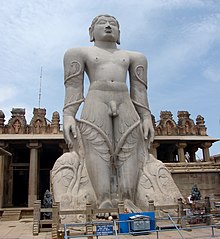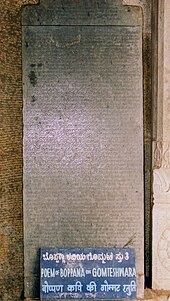Bahubali
| Bahubali | |
|---|---|
 The 65 ft high Gommateshwara statue at Shravanabelagola, Karnataka, India, was built in 983 CE. | |
| Other names | Gommateshwara, Kammateshwara |
| Affiliation | Jainism |
| Height | 525 bows (17 metres) |
| Personal information | |
| Born | |
| Died | |
| Parents |
|
| Siblings | Sundarī (sister) Bharata, Nami, and 97 other (step-brothers) Brāhmī (step-sister) |
| Children | Mahābala Somakīrti[1] |
| Part of a series on |
| Jainism |
|---|
 |
Bahubali (
Bahubali's other names are Kammateshwara and Gommateshwara, the namesake of the Gommateshwara statue dedicated to him.
Legends
The
Family life

According to Jain texts, Bahubali was born to Rishabhanatha and Sunanda during the
The ministers on both sides gave the following argument to prevent war; "The brothers themselves, cannot be killed by any means; they are in their last incarnations in transmigration, and possess bodies which no weapon may mortally wound in warfare! Let them fight out the issue by themselves in other ways."[11] It was then decided that to settle the dispute, three kinds of contests between Bharata and Bahubali would be held. These were eye-fight (staring at each other)(drishti-yuddha), water-fight (jala-yuddha), and wrestling (malla-yuddha). Bahubali won all the three contests over his elder brother, Bharata.[7][12]
Renunciation

After the fight, Bahubali was filled with disgust at the world and developed a desire for renunciation. Bahubali abandoned all possessions-kingdom, clothes, ornaments-to become a monk and began meditating with great resolve to attain omniscience (kevala jnana).[13]
He is said to have meditated motionless in a standing posture (
Statues
Karnataka
There are five monolithic statues of Bahubali measuring more than 6 m (20 feet) in height in Karnataka:
- 17.4 m (57 feet) at
- 12.8 m (42 feet) at Udupi District in 1430[19]
- 11.9 m (39 feet) at Dharmasthala in Dakshina Kannada District in 1973[19]
- 10.7 m (35 feet) at Venur in Dakshina Kannada District in 1604[19]
- 6 m (17.5 feet) at Mysore District in 14th century CE[20]
Maharashtra
- 8m (28 feet) at Kumbhoj in Kolhapur district in 1963[21]
Tamil Nadu
- 7.3 m (24 feet) at Ponnur in Tiruvannamalai District in 2023.
Shravanabelagola
The monolithic statue of Bahubali at Shravanabelagola, located 158 km (98 mi) from
Karkala

Karkala is known for its 42 ft (13 m) monolithic statue of Gomateshwara Bahubali, which is believed to have been built around 1432 and is the second-tallest statue in the State.[19][25] The statue is built on an elevated platform on top of a rocky hill. It was consecrated on 13 February 1432 by Veera Pandya Bhair Arasa Wodeyar, scion of the Bhair Arasa dynasty, feudatory of the Vijayanagar Ruler.[19][26]
Dharmastala

A 39-foot (12 m) high statue with a 13-foot (4.0 m) pedestal that weighs about 175 t (175,000 kg) is installed at Dharmasthala in Karnataka.[19]
Venur

Venur is a small town in Dakshina Kannada district, Karnataka state, situated on the bank of the Gurupura River. Thimmanna Ajila built a 38-foot (12 m) colossus of Gommateshwara there in 1604.[25][19][27] The statue at Venur is the shortest of the three Gommateshwaras within 250 km (160 mi) around it. It stands in an enclosure on the same pattern as that of the statue at Shravanabelagola. The Kings of Ajila Dynasty ruled here from 1154 to 1786.[28]
Gommatagiri

Gommatagiri is an acclaimed Jain centre. The 12th-century granite statue of Bahubali, also known as Gomateshwara, is erected atop a 50-metre (160 ft) tall hillock called 'Shravana Gudda'.[20] The Jain centre attracts many pilgrims during the annual Mahamastakabhisheka in September.[20][25] The statue at Gommatagiri is very similar to the 58-foot (18 m) Gommateshwara statue in Shravanabelagola, except that it is smaller. Historians attribute the statue to an early Vijayanagar period.[20]
Kumbhoj

Kumbhoj is the name of an ancient town located in Kolhapur district, Maharashtra. The town is about eight kilometers from Hatkanangale, about twenty seven kilometers from Kolhapur. The famous Jain pilgrimage centre where a 28-foot (8.5 m)-high statue of Bahubali is installed is 2 kilometres (1.2 mi) from the Kumbhoj city.[29]
Aretipur
There is a 10-foot (3.0 m)-high statue of Bahubali at Aretipur, Near Kokrebellur Village of Madur Taluk Mandya district.[30]
In 2016, the Archaeological Survey of India (ASI) excavated another 13 ft (4.0 m)-high statue of Bahubali made in the 3rd – 9th centuries in Aretipur.[31] ASI has also excavated an 8th-century statue of Bahubali in Aretipur, Maddur, Mandya, Karnataka, that is 3 feet (0.91 m) wide and 3.5 ft (1.1 m) tall.[32]
In literature

The life-story of Bahubali has been discussed in many works.
Sanskrit
- The
- Bahubali charitra written in the 9th century CE[35]
Prakrit
- Gommatesha-thudi, a religious hymn in praise to Bahubali, was composed by Nemichandra in 10th century CE.[36]
- Gommatasa-sara, composed by Nemichandra, mentions the story of construction of the Gommateshwara statue by Chavundaraya.[37]
Kannada
- A 10th-century Kannada text based on the Sanskrit text was written by the poet Adikavi Pampa.[38][39]
- Gommata-stuti is a poem dated 1180 was composed by a Jain poet named Boppanna (also known as Sujanottamsa), in praise of Bahubali.[40][41]
- Karkala Gommatesvara Charitre, composed by Chadura Chandrama in 1686 CE, is poem describing the mahamastakabhisheka at Karkala.[42]
Rajasthani
- Bharateshwara Bahubali Ghora composed by Vajrasena Suri in 1168, is a poem with 48 verses describing the battle between Bharata and Bahubali.[43]
Gujarati
- Bharateshwara Bahubaliras composed by Shalibhadra Suri in 1184, is a poem with 203 stanzas describing the struggle of power between Bharata and Bahubali.[43][44][45]
Images
Pictured below are some of the images depicting Bahubali that are located at various places in India.
-
Bahubali, Metropolitan Museum of Art (6th CE)
-
Indra Sabha, Ellora Caves (9th CE)
-
Bahubali monolith at Halebidu (12th CE)
-
Miniature version of the Gommateshwara statue at Shravanabelagola
-
Bahubali statue at YSR state Archaeology Museum, Hyderabad, 12th century
-
31-foot (9.4 m) statue of Bahubali at Bada Gaon
-
Gomateshwara at Kalugumalai Jain Beds, 8th century
-
Bahubali at Andimalai Caves, 10th century
-
Bahubali at Aretipur
See also
References
Citations
- ^ a b Champat Rai Jain 1929, p. 106.
- ^ Granoff 1993, p. 208.
- ^ a b c d Sangave 1981, p. 66.
- ^ a b Zimmer 1953, p. 212.
- ^ Champat Rai Jain 1929, p. xv.
- ^ Dundas 2002, p. 120.
- ^ a b c Sangave 1981, p. 67.
- ^ Vijay K. Jain 2013, p. x.
- ^ Vijay K. Jain 2013, p. xi.
- ^ Champat Rai Jain 1929, p. 143.
- ^ Champat Rai Jain 1929, p. 144.
- ^ Champat Rai Jain 1929, p. 105.
- ^ Champat Rai Jain 1929, p. 145.
- ^ a b Champat Rai Jain 1929, pp. 145–146.
- ISBN 978-81-263-1844-5.
- ^ Champat Rai Jain 1929.
- ^ Champat Rai Jain 1929, p. 146.
- ^ Sangave 1981, p. 25.
- ^ Times News Network
- ^ a b c d "Gommatagiri statue crying for attention", The Hindu, 22 January 2006
- ^ "Lord Bahubali of Kumbhoj [Statue]". KolhapurTravels.com.
- ^ Rice 1889, p. 53.
- ^ March of Mysore, vol. 3, University of California, 1966, p. 56
- ^ "Bahubali Mahamastakabhisheka Mahotsav: Here is the history of the Jain festival PM Modi attended today", The Indian Express, 19 February 2018
- ^ a b c Sangave 1981, p. 90.
- ^ "Bahubali abhisheka from today", The Hindu, 21 January 2015
- ^ Titze 1998, p. 48.
- TNN
- ^ Sangave 1981, p. 91.
- ^ "Bahubali of Aretipur", Frontline, 29 April 2016
- ^ Girish, M. B. (23 February 2016) [4 December 2015], "Another Jain centre under excavation in Mandya district", Deccan Chronicle
- ^ "Eighth Century Jain Temple Discovered in Maddur", The New Indian Express, Express News Service, 7 January 2015, archived from the original on 10 January 2015
- ^ Sangave 2001, p. 215.
- ^ Sangave 1981, p. 72.
- ^ Sangave 1981, p. 51.
- ^ Sangave 2001, p. 240.
- ^ Sangave 1981, p. 75.
- ^ "History of Kannada literature", kamat.com
- ISBN 0-85229-760-2
- ^ Sangave 1981, p. 84.
- ^ Settar 1989, p. 264.
- ^ Reddy 2022, p. 231.
- ^ a b Datta 1987, p. 454.
- ^ Paniker 1997, p. 94.
- ^ Mukherjee 1998, p. 44.
Sources
- ISBN 9788126018031
- ISBN 0-415-26605-X
- ISBN 81-208-1150-X
- Allahabad: The Indian Press Limited,.
 This article incorporates text from this source, which is in the public domain
This article incorporates text from this source, which is in the public domain - Jain, Vijay K. (2013), Ācārya Nemichandra's Dravyasaṃgraha, Vikalp Printers, ISBN 978-81-903639-5-2,.
 This article incorporates text from this source, which is in the public domain
This article incorporates text from this source, which is in the public domain - ISBN 9788125014539
- ISBN 9788126003655
- Rice, Benjamin Lewis (1889), Inscriptions at Sravana Belgola: a chief seat of the Jains, (Archaeological Survey of Mysore), Mysore: Government Central Press
- ISBN 978-93-56114-46-3.
- Sangave, Vilas Adinath (1981), The Sacred Shravanabelagola (A Socio-Religious Study) (1st ed.), Bharatiya Jnanpith
- ISBN 978-81-7154-839-2
- ISBN 9789004087903
- Titze, Kurt (1998), Jainism: A Pictorial Guide to the Religion of Non-Violence (2 ed.), ISBN 81-208-1534-3
- ISBN 978-81-208-0739-6









